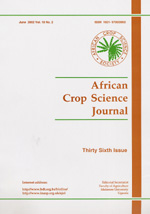
|
African Crop Science Journal
African Crop Science Society
ISSN: 1021-9730
EISSN: 1021-9730
Vol. 17, No. 2, 2009, pp. 61-69
|
 Bioline Code: cs09006
Bioline Code: cs09006
Full paper language: English
Document type: Research Article
Document available free of charge
|
|
|
African Crop Science Journal, Vol. 17, No. 2, 2009, pp. 61-69
| fr |
Das, S.; Misra, R. C.; Rout, G.R.; Pattanaik, M.C. & Aparajita, S.
Résumé
Une characterisation moléculaire des 15 génotypes de millet ( Eleusine coracana

G) à maturité précoce avait été
faite à l'aide des marqueurs RAPD. Vingt-cinq apprêts avaient été utilisés pour une sélection initiale. De ceux-ci,
neuf apprêts (OPA4, OPA13, OPA16, OPC12, OPC18, OPD8, OPN7, OPN15 et OPN16) s'étaient révélés de
modèle de repartition en groupes de niveau dans le primaire polymorphique pour les génotypes. Un nombre total
de bandes produites rangés de 2 à 9 bandes par apprêts. Les neuf apprêts avaient produit 60 produits
d'amplification, dont 9 étaient monomorphiques et 51 étaient polymorphes. Les apprêts OPA4, OPC18 et
OPN15 avaient produit le plus grand nombre de bandes polymorphiques que OPA16 et OPN16. Le polymorphisme
allait de 50 à 100 %. L'apprêts OPA13, OPC18 et OPN15 s'étaient révélés d'un polymorphisme de 100 %, alors
que OPA16 et OPN16 d'un polymorphisme de 50 %. Afin d'étudier la relation entre la présence/absence de bande
polymorphique avec adaptation génotypique, les 15 génotypes de millet étaient classés en groupe '+' pour la
présence et en groupe '–' pour l'absence de bande-OPA4 ~ 1800 bp, OPC12 ~ 900 bp, OPD8 ~ 850 bp, OPN7
~ 2600 bp, OPN15 ~ 2500 bp, OPN15 ~ 900 bp et OPN16 ~ 2600 bp. Les génotypes étaient également classifiés
en classes à haut rendement (HY) et à faible rendement (LY), deux classes d'adaptabilité, c'est-à-dire spécifiquement adaptées aux environnements riches et spécifiquement adaptés aux environnements pauvres ; également en deux
classes de stabilité, c'est-à-dire stables (S) et instable (U). Cette expérimentation avait révélé que la présence de
OPA4 ~ 1800 bp et l'absence de OPN15 ~ 900 bp bandes dans le millet ( Eleusine coracana G) peuvent donner
d'indication sur l'adaptation spécifique des génotypes aux environnements pauvres. L'absence de OPA4 ~ 1800
bp et la présence de OPN15 ~ 900 bp indiquerait une adaptation génotypique spécifique aux environnements
riches. Ces conclusions peuvent aider à prédire l'adaptation génotypique de différents génotypes avant de
procéder à un essai multilocal.
Mots Clés
Eleusine coracana, adaptation génotypique, marqueurs moléculaires
|
| |
| en |
Relationship of status of polymorphic RAPD bands with genotypic adaptation in early finger millet genotypes
Das, S.; Misra, R. C.; Rout, G.R.; Pattanaik, M.C. & Aparajita, S.
Abstract
Molecular characterisation of the 15 early duration finger millet ( Eleusine coracana

G) genotypes was done
through RAPD markers. Twenty-five decamer primers were used for initial screening. Of these nine primers
(OPA4, OPA13, OPA16, OPC12, OPC18, OPD8, OPN7, OPN15 and OPN16) showed polymorphic banding
pattern for the genotypes. Total number of bands produced ranged from 2 to 9 bands per primer. The nine
primers produced 60 amplification products, of which 9 were monomorphic and 51 were polymorphic. The
primers OPA4, OPC18 and OPN15 produced a greater number of polymorphic bands than OPA16 and OPN16.
Polymorphism ranged from 50 to 100%. Primers OPA13, OPC18 and OPN15 revealed 100% polymorphism,
whereas OPA16 and OPN16 showed 50%. In order to study the relationship of presence/absence of a polymorphic
band with genotypic adaptation, the 15 early finger millet genotypes were classified into '+' group for
presence and '–' group for absence of the band-OPA4~1800 bp, OPC12~900 bp, OPD8~850 bp, OPN7~2600
bp, OPN15~2500 bp, OPN15~900 bp and OPN16~2600 bp. The genotypes were also classified into highyielding
(HY) and low-yielding (LY) classes, two adaptability classes, i.e. specifically adapted to rich environments
and specifically adapted to poor environments and into two stability classes, i.e. stable(S) and unstable
(U). This experiment revealed that the presence of OPA4~1800 bp and absence of OPN15~900 bp bands in finger
millet may give some indication about specific adaptability of genotypes to poor environments. Absence of
OPA4~1800 bp and presence of OPN15~900 bp would indicate specific genotypic adaptation to rich environments.
These findings may help to predict the genotypic adaptation of different genotypes before going for
multilocation trial.
Keywords
Eleusine coracana, genotypic adaptation, molecular markers
|
| |
© Copyright 2009 - African Crop Science Society
|
|
